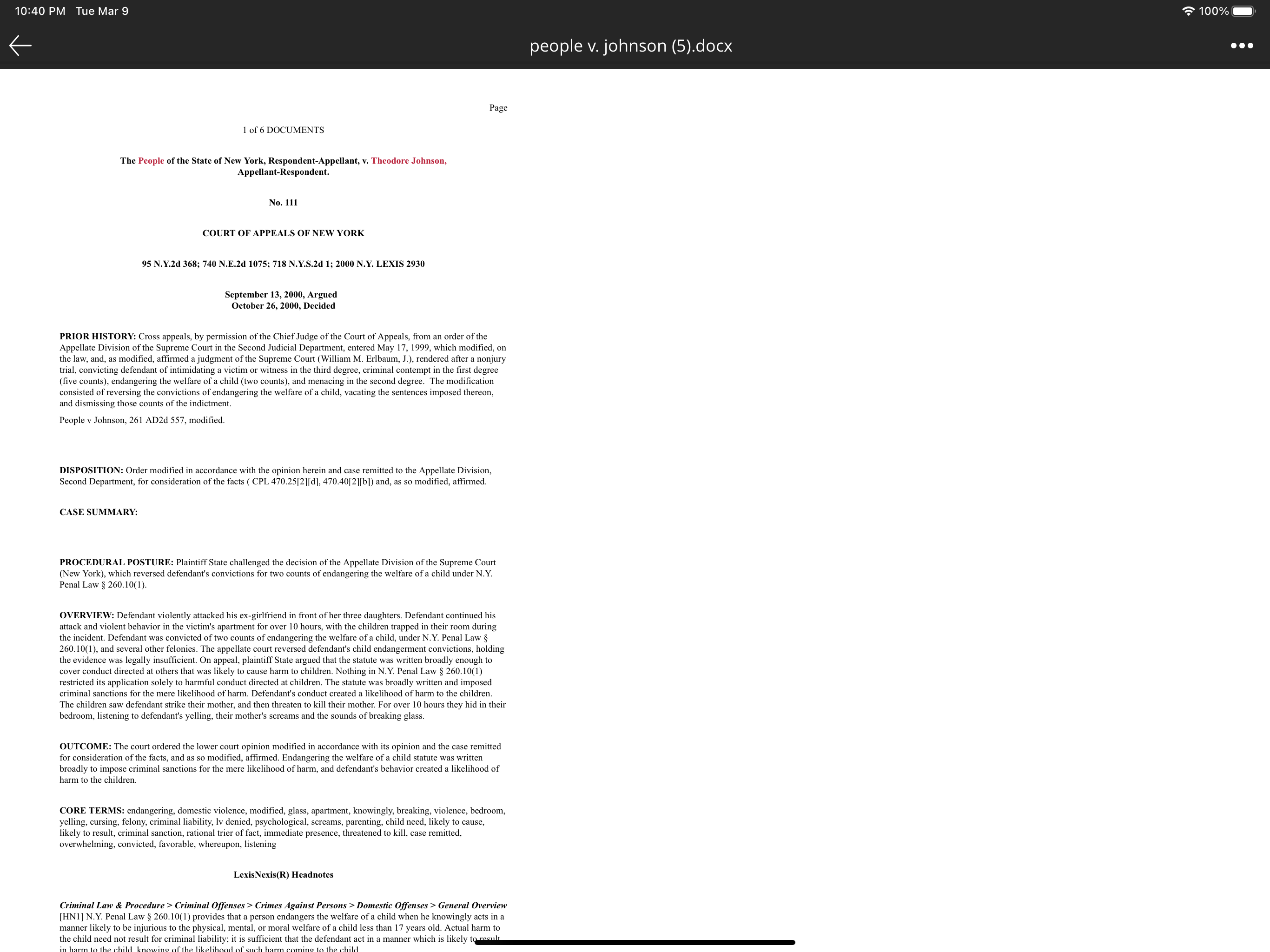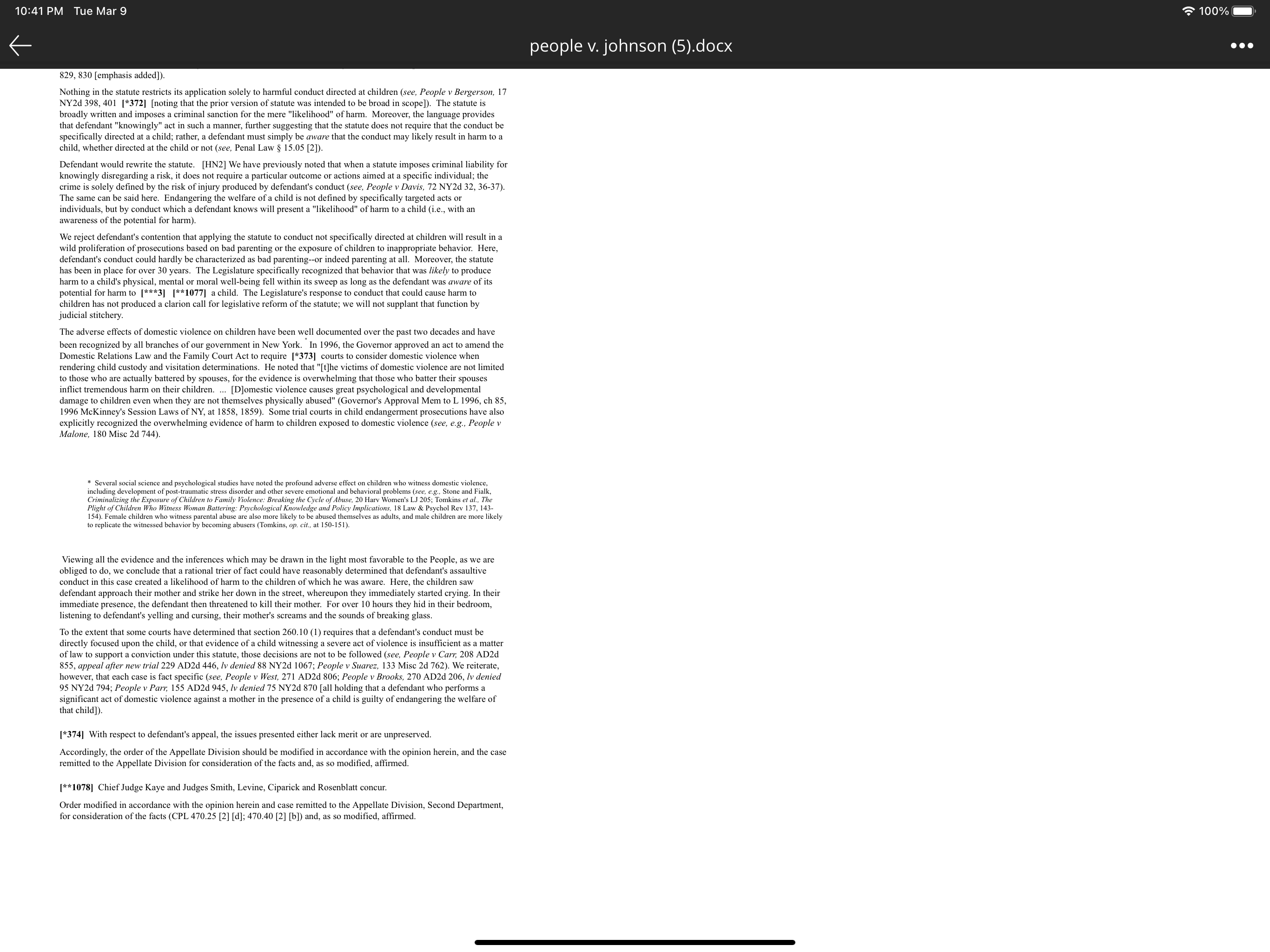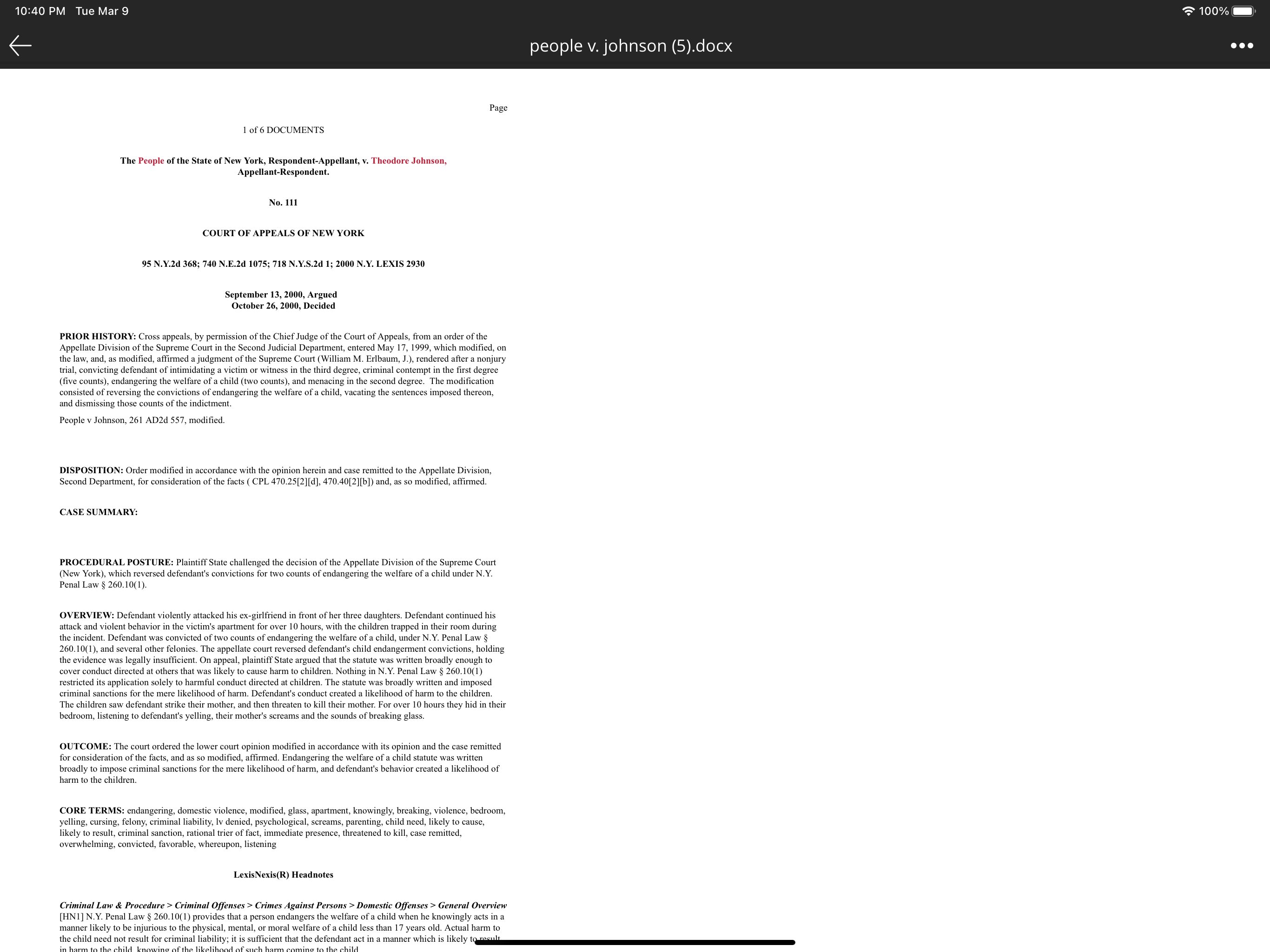

What happened and what was the decision made in People v. Johnson case?
why court of people made this decision(the reasons behind it)?
what are the things court of Appellate focused
10:40 PM Tue Mar 9 100% people v. johnson (5).docx . . . Page 1 of 6 DOCUMENTS The People of the State of New York, Respondent-Appellant, v. Theodore Johnson, Appellant-Respondent. No. 111 COURT OF APPEALS OF NEW YORK 95 N.Y.2d 368; 740 N.E.2d 1075; 718 N.Y.S.2d 1; 2000 N.Y. LEXIS 2930 September 13, 2000, Argued October 26, 2000, Decided PRIOR HISTORY: Cross appeals, by permission of the Chief Judge of the Court of Appeals, from an order of the Appellate Division of the Supreme Court in the Second Judicial Department, entered May 17, 1999, which modified, on the law, and, as modified, affirmed a judgment of the Supreme Court (William M. Erlbaum, J.), rendered after a nonjury trial, convicting defendant of intimidating a victim or witness in the third degree, criminal contempt in the first degree (five counts), endangering the welfare of a child (two counts), and menacing in the second degree. The modification consisted of reversing the convictions of endangering the welfare of a child, vacating the sentences imposed thereon, and dismissing those counts of the indictment. People v Johnson, 261 AD2d 557, modified. DISPOSITION: Order modified in accordance with the opinion herein and case remitted to the Appellate Division, Second Department, for consideration of the facts ( CPL 470.25[2] [d], 470.40[2][b]) and, as so modified, affirmed. CASE SUMMARY: PROCEDURAL POSTURE: Plaintiff State challenged the decision of the Appellate Division of the Supreme Court New York), which reversed defendant's convictions for two counts of endangering the welfare of a child under N.Y. Penal Law $ 260.10(1). OVERVIEW: Defendant violently attacked his ex-girlfriend in front of her three daughters. Defendant continued his attack and violent behavior in the victim's apartment for over 10 hours, with the children trapped in their room during he incident. Defendant was convicted of two count d, under N.Y. Penal Law $ 260.10(1), and several other felonies. The appellate court reversed defendant's child endangerment convictions, holding the evidence was legally insufficient. On appeal, plaintiff State argued that the statute was written broadly enough to cover conduct directed at others that was likely to cause harm to children. Nothing in N.Y. Penal Law $ 260.10(1) restricted its application solely to har . The statute was broadly written and imposed criminal sanctions for the mere likelihood of harm. Defendant's conduct created a likelihood of harm to the children. The children saw defendant strike their mother, and then threaten to kill their mother. For over 10 hours they hid in their bedroom, listening to defendant's yelling, their mother's screams and the sounds of breaking glass. OUTCOME: The court ordered the lower court opinion modified in accordance with its opinion and the case remitted for consideration of the facts, and as so modified, affirmed. Endangering the welfare of a child statute was written broadly to impose criminal sanctions for the mere likelihood of harm, and defendant's behavior created a likelihood of harm to the children. CORE TERMS: endangering, domestic violence, modified, glass, apartment, knowingly, breaking, violence, bedroom, yelling, cursing, felony, criminal liability, Iv denied, psychological, screams, parenting, child need, likely to cause, likely to result, criminal sanction, rational trier of fact, immediate presence, threatened to kill, case remitted, overwhelming, convicted, favorable, whereupon, listening LexisNexis(R) Headnotes Criminal Law & Procedure > Criminal Offenses > Crimes Against Persons > Domestic Offenses > General Overview [HN1] N. Y. Penal Law $ 260.10(1) provides that a person endangers the welfare of a child when he knowingly acts in manner likely to be injurious to the physical, mental, or moral welfare of a child less than 17 years old. Actual harm to he child need not result for criminal liability; it is sufficient that the defendant act in a manner which is likely to result10:41 PM Tue Mar 9 100% people v. johnson (5).docx . . . 829, 830 [emphasis added]). Nothing in the statute restricts its application solely to harmful conduct directed at children (see, People v Bergerson, 17 NY2d 398, 401 [*372] [noting that the prior version of statute was intended to be broad in scope]). The statute is broadly written and imposes a criminal sanction for the mere "likelihood" of harm. Moreover, the language provides that defendant "knowingly" act in such a manner, further suggesting that the statute does not require that the conduct be specifically directed at a child; rather, a defendant must simply be aware that the conduct may likely result in harm to a child, whether directed at the child or not (see, Penal Law $ 15.05 [2]). Defendant would rewrite the statute. [HN2] We have previously noted that when a statute imposes criminal liability for knowingly disregarding a risk, it does not require a particular outcome or actions aimed at a specific individual; the crime is solely defined by the risk of injury produced by defendant's conduct (see, People v Davis, 72 NY2d 32, 36-37). The same can be said here. Endangering the welfare of a child is not defined by specifically targeted acts or individuals, but by conduct which a defendant knows will present a "likelihood" of harm to a child (i.e., with an awareness of the potential for harm). We reject defendant's contention that applying the statute to conduct not specifically directed at children will result in a wild proliferation of prosecutions based on bad parenting or the exposure of children to inappropriate behavior. Here, defendant's conduct could hardly be characterized as bad parenting--or indeed parenting at all. Moreover, the statute has been in place for over 30 years. The Legi avior that was likely to produce harm to a child's physical, mental or moral well-being fell within its sweep as long as the defendant was aware of its potential for harm to [* * *3] [* *1077] a child. The Legislature's response to conduct that could cause harm to children has not produced a clarion call for legislative reform of the statute; we will not supplant that function by judicial stitchery. The adverse effects of domestic violence on children have been well documented over the past two decades and have been recognized by all branches of our government in New York. In 1996, the Governor approved an act to amend the Domestic Relations Law and the Family Court Act to require [*373] courts to consider domestic violence when rendering child custody and visitation determinations. He noted that "[the victims of domestic violence are not limited to those who are actually battered by spouses, for the evidence is overwhelming that those who batter their spouses inflict tremendous harm on their children. ... uses great psychological and developmental damage to children even when they are not themselves physically abused" (Governor's Approval Mem to L 1996, ch 85, 1996 Mckinney's Session Laws of NY, at 1858, 1859). Some trial courts in child endangerment prosecutions have also explicitly recognized the overwhelming evidence of harm to children exposed to domestic violence (see, e.g., People v Malone, 180 Misc 2d 744). ent of post-traumatic stress dis have noted the profound adverse effect on children who witness domestic violence, including development of post-traumatic stress disorder and other severe emotional and behavioral problems (see, e.g., Stone and Fialk, Criminalizing the Exposure of Children to Family Violence: Br y Violence: Breaking the C Cycle of Abuse, 20 Harv Women's LJ 205; Tomkins et al., The Plight of Children Who Witness Woman Battering: Psychological Knowledge and Policy Implications, 18 Law & Psychol Rev 137, 143- 154). Female children who witness parental abuse are also more likely to be abused themselves as adults, and male chagKey to replicate the witnessed behavior by becoming abusers ( Tomkins, op. cit., at 150-151). s, and male children are more likely Viewing all the evidence and the inferences which may be drawn in the light most favorable to the People, as we are obliged to do, we conclude that a rational trier of fact could have reasonably determined that defendant's assaultive conduct in this case created a likelihood of harm to the children of which he was aware. Here, the children saw defendant approach their mother and strike her down er down in the street, whereupon they immediately started crying. In their immediate presence, the defendant then threatened to kill their mother. For over 10 hours they hid in their bedroom, listening to defendant's yelling and cursing, their mother's screams and the sounds of breaking glass. To the extent that some courts have determined that section 260.10 (1) requires that a defendant's conduct must be directly focused upon the child, or that evide evidence of a child witnessing a severe act of violence is insufficient as a matter of law to support a conviction under this statute, those decisions are not to be followed (see, People v Carr, 208 AD2d 855, appeal after new trial 229 AD2d 446, lv denied 88 NY2d 1067; People v Suarez, 133 Misc 2d 762). We reiterate, however, that each case is fact specific (see, People v West, 271 AD2d 806; People v Brooks, 270 AD2d 206, lv denied 95 NY2d 794; People v Parr, 155 AD2d 945, lv denied 75 NY2d 870 [all holding that a defendant who performs a significant act of domestic violence against a mother in the presence of a child is guilty of endangering the welfare of that child]). [*374] With respect to defendant's appeal, the issues presented either lack merit or are unpreserved. Accordingly, the order of the Appellate Division should be modified in accordance with the opinion herein, and the case emitted to the Appellate Division for consideration of the facts and, as so modified, affirmed. (**1078] Chief Judge Kaye and Judges Smith, Levine, Ciparick and Rosenblatt concur. Order modified in accordance with the opinion herein and case remitted to the Appellate Division, Second Department, for consideration of the facts (CPL 470.25 [2] [dj; 470.40 [2] [b]) and, as so modified, affirmed










